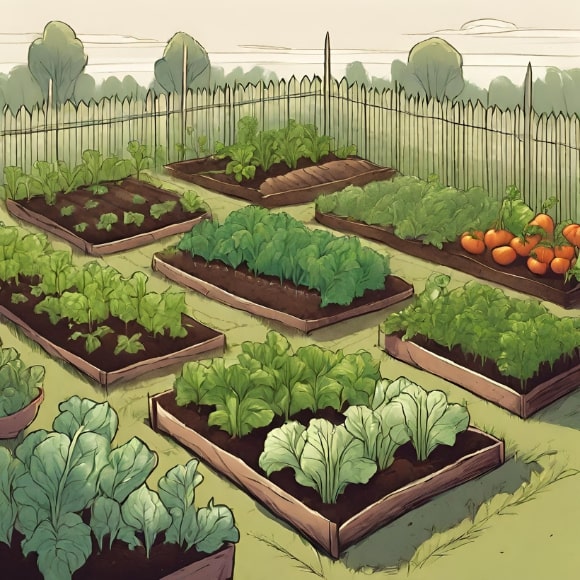
The history of vegetable gardens in America is a tapestry woven with threads of tradition, innovation, and resilience. From the earliest Native American agricultural practices to the modern urban gardening movement, vegetable gardens have played a central role in shaping the landscape, culture, and identity of the nation. Let’s explore the rich and complex history of vegetable gardening in America.
Indigenous Agricultural Traditions
Long before the arrival of European settlers, indigenous communities across North America cultivated an impressive array of crops, including maize, beans, squash, and sunflowers. These early agricultural practices were rooted in a deep understanding of the land, with planting techniques tailored to the unique ecosystems of different regions. The Three Sisters planting method, for example, which involves interplanting corn, beans, and squash, exemplifies the symbiotic relationship between crops and showcases indigenous knowledge of companion planting and soil fertility.
Colonial Gardening: Seeds of Change
The arrival of European settlers in the 17th century brought about significant changes to American gardening practices. Colonists brought with them seeds, plants, and gardening techniques from their homelands, introducing a wide variety of new crops to the continent. In colonial America, vegetable gardens—often referred to as kitchen gardens—were essential for providing sustenance to households, supplementing diets of preserved food with fresh produce, herbs, and medicinal plants. These gardens were meticulously planned and tended, reflecting the settlers’ reliance on gardening for survival in a new world.
The Rise of Horticultural Societies
As the young nation expanded westward, so too did its horticultural ambitions. In the 19th century, the establishment of horticultural societies and agricultural fairs provided a platform for gardeners to showcase their skills, exchange seeds and plants, and learn from one another. These organizations played a crucial role in disseminating gardening knowledge, promoting the cultivation of new and exotic crops, and fostering a sense of community among garden enthusiasts. The Philadelphia Horticultural Society, founded in 1827, stands as one of the oldest and most influential horticultural societies in America, exemplifying the spirit of innovation and camaraderie that defined the era.
Gardening During Times of Adversity
Throughout American history, vegetable gardens have served as a source of resilience and sustenance during times of adversity. During the Civil War, for example, both Union and Confederate soldiers relied on vegetable gardens to supplement their rations and stave off hunger. Similarly, the victory gardens of World Wars I and II played a vital role in bolstering food production on the home front, enabling citizens to contribute to the war effort while ensuring their own food security. These gardens symbolized the power of collective action and the ability of individuals to make a difference in times of crisis.
The Suburban Garden Boom
The post-World War II era witnessed a surge in suburbanization and the rise of the American Dream—a dream that often included a house with a backyard garden. Suburbanites embraced gardening as a means of connecting with nature, beautifying their surroundings, and providing fresh produce for their families. The advent of mass-produced gardening tools, seed catalogs, and chemical fertilizers further fueled the suburban garden boom, making gardening more accessible to the masses. Victory gardens were repurposed into family gardens, where tomatoes, cucumbers, and peppers flourished alongside roses and petunias, creating a picturesque landscape of abundance.
The Back-to-the-Land Movement
In the turbulent 1960s and 1970s, a countercultural movement emerged that sought to reject the consumerism and conformity of mainstream society in favor of a simpler, more self-sufficient way of life. Known as the back-to-the-land movement, this phenomenon saw droves of urbanites leave the city behind in search of rural homesteads where they could live off the land. Vegetable gardening played a central role in this lifestyle, providing a means of producing food, reducing dependence on industrial agriculture, and reconnecting with the rhythms of nature.
Urban Gardening Renaissance
In recent decades, a renewed interest in urban gardening has taken root in cities across America. Fueled by concerns about food security, environmental sustainability, and community resilience, urban dwellers are reclaiming vacant lots, rooftops, and abandoned spaces to create vibrant urban gardens. Community gardens have emerged as focal points for social interaction, education, and collective action, bringing together people from diverse backgrounds to grow food, build community, and beautify neighborhoods. The rise of urban agriculture initiatives, such as rooftop farms, vertical gardens, and aquaponic systems demonstrates the potential for innovative gardening practices to thrive in an urban environment.
The Future of Vegetable Gardening
As we look to the future, the history of vegetable gardening in America serves as both a guide and an inspiration. In an era of climate change and resource scarcity, the principles of sustainability, resilience, and community engagement embodied by vegetable gardening are more relevant than ever. As we tend to our gardens, we cultivate not just plants but also a way of life—a way of life rooted in stewardship and sustainability, tied to the rhythms of nature.


 Previous
Previous

